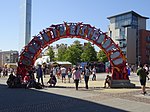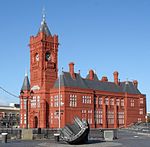Roald Dahl Plass

Roald Dahl Plass is a public space in Cardiff Bay, Cardiff, Wales. It is named after Cardiff-born author Roald Dahl, and is located on the coast along the south of the city centre. The square is home to the Senedd building housing the Senedd, the Welsh parliament, and the Wales Millennium Centre, a performing arts centre. The bowl-like shape of the space has made it a popular amphitheatre for hosting open-air concerts.Formerly named the Oval Basin and known as the Bowl, the area was one of the docks for a thriving coal port during the latter half the 19th century and much of the 20th century. Following World War II, the space entered a period of decay and dereliction until the 1980s, when the Cardiff Bay area was regenerated.The name is a nod to the writer's roots (both of Dahl's parents were from Norway) and to the Norwegian seafarers' church which stands nearby. "Plass" is the Norwegian cognate of the English word "place;" in this context the word means square in Norwegian, although the word can also mean "space" or "place." However, in Norwegian the name of a square named after a person would correctly be written in the genitive case, in this case as "Roald Dahls plass" (literally, "Roald Dahl's square"). The word "plass" is not capitalized in modern (post-1907) Norwegian.
Excerpt from the Wikipedia article Roald Dahl Plass (License: CC BY-SA 3.0, Authors, Images).Roald Dahl Plass
Roald Dahl Plass, Cardiff Cardiff Bay
Geographical coordinates (GPS) Address Nearby Places Show on map
Geographical coordinates (GPS)
| Latitude | Longitude |
|---|---|
| N 51.463927777778 ° | E -3.1641972222222 ° |
Address
Wagamama
Roald Dahl Plass U12
CF10 5BZ Cardiff, Cardiff Bay
Wales, United Kingdom
Open on Google Maps









